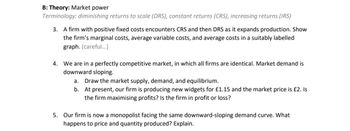
ENGR.ECONOMIC ANALYSIS
14th Edition
ISBN: 9780190931919
Author: NEWNAN
Publisher: Oxford University Press
expand_more
expand_more
format_list_bulleted
Question
Can you help me to draw a graph for question 5 please? Thanks

Transcribed Image Text:B: Theory: Market power
Terminology: diminishing returns to scale (DRS), constant returns (CRS), increasing returns (IRS)
3. A firm with positive fixed costs encounters CRS and then DRS as it expands production. Show
the firm's marginal costs, average variable costs, and average costs in a suitably labelled
graph. (careful...)
4. We are in a perfectly competitive market, in which all firms are identical. Market demand is
downward sloping.
a. Draw the market supply, demand, and equilibrium.
b.
At present, our firm is producing new widgets for £1.15 and the market price is £2. Is
the firm maximising profits? Is the firm in profit or loss?
5. Our firm is now a monopolist facing the same downward-sloping demand curve. What
happens to price and quantity produced? Explain.
Expert Solution
This question has been solved!
Explore an expertly crafted, step-by-step solution for a thorough understanding of key concepts.
Step by stepSolved in 2 steps with 1 images

Knowledge Booster
Learn more about
Need a deep-dive on the concept behind this application? Look no further. Learn more about this topic, economics and related others by exploring similar questions and additional content below.Similar questions
- In 2004, Safari Corporation’s total sales reached $1.2 million. By 2010, sales had climbed to $4.25 million. What is the growth in sales for Safari Corporation per year?arrow_forwardQuestion 21 The payoff matrix for two companies is seen below. The profits for Netflix are in the upper right hand corner, while the profits for Hulu are in the lower left hand corner. If Netflix raises their price, what is the best response by Hulu?arrow_forwardCould you list the equations for each solution?arrow_forward
- choices for 1 and 2 are its either "variable" or "fixed" please also do the rest of the questions and graph thank you!arrow_forwardCan you help with the three questions on my worksheet that relate to the attached graph? Can you also advise if I have done my math correctly?arrow_forwardTotal Total Total Product Fixed Variable (Blankets) Cost Cost 0 A 0 1 60 25 2 60 40 3 60 I 4 60 55 5 60 55 6 60 70 7 60 100 8 60 145 A What is the numerical value of B? A/ What is the numerical value of C? A/ Total Cost What is the numerical value of D? B 85 100 110 G 115 130 160 205 Average Average Average Variable Total Fixed Cost Cost cost - с 60 30 20 15 12 8.6 7.5 25 20 16.7 13.8 Ꭰ 11.7 14.3 18.1 E The table describes the short-run daily costs of the Baby Blanket Company. What is the numerical value of A? 85 36.7 28.8 J 21.7 22.9 25.6 Marginal Cost F H 15 10 0 15 30 45arrow_forward
- A Homework (Ch 08) * Mind Tap - Cengage Learning catic/nb/ui/evo/index.html?deploymentld=58830023220612202193347127562&elSBN=97813376223498&id=9084911198&snapshotld=1937530& Q Search CENGAGE MINDTAP lomework (Ch 08) 5. Deriving the short-run supply curve Consider the perfectly competitive market for halogen lamps. The following graph shows the marginal cost (MC), average total cost (ATC), and average variable cost (AVC) curves for a typical firm in the industry. 80 72 64 56 48 ATCA 40 32 24 16 AVC MCO 8 16 QUANTITY OF OUTPUT (Thousands of lamps) 24 32 40 48 56 64 72 80 14 5 go 19 194 ho. pll fg DII DDI delete home enc $. & * 5 7. 8. 9. num %3D backspace lock { R. V D. PER UNT (Dollars)arrow_forwardplease graph!arrow_forwardConsider the following data on a firm: Number of Units Sold Total Revenue (£'s) 10 20 30 40 50 60 70 100 180 240 280 300 300 280 Fixed Costs are £100, Variable costs are constant at £3 per (i) Write a table showing the price and quantity sold. (ii) Calculate the profit maximising output of the firm (iii) What are the profits at the profit maximising output? (v) unit produced. (iv) What is the average variable cost at the profit maximising output? What is the arc price elasticity of demand between 40 and 50 units?arrow_forward
arrow_back_ios
arrow_forward_ios
Recommended textbooks for you

 Principles of Economics (12th Edition)EconomicsISBN:9780134078779Author:Karl E. Case, Ray C. Fair, Sharon E. OsterPublisher:PEARSON
Principles of Economics (12th Edition)EconomicsISBN:9780134078779Author:Karl E. Case, Ray C. Fair, Sharon E. OsterPublisher:PEARSON Engineering Economy (17th Edition)EconomicsISBN:9780134870069Author:William G. Sullivan, Elin M. Wicks, C. Patrick KoellingPublisher:PEARSON
Engineering Economy (17th Edition)EconomicsISBN:9780134870069Author:William G. Sullivan, Elin M. Wicks, C. Patrick KoellingPublisher:PEARSON Principles of Economics (MindTap Course List)EconomicsISBN:9781305585126Author:N. Gregory MankiwPublisher:Cengage Learning
Principles of Economics (MindTap Course List)EconomicsISBN:9781305585126Author:N. Gregory MankiwPublisher:Cengage Learning Managerial Economics: A Problem Solving ApproachEconomicsISBN:9781337106665Author:Luke M. Froeb, Brian T. McCann, Michael R. Ward, Mike ShorPublisher:Cengage Learning
Managerial Economics: A Problem Solving ApproachEconomicsISBN:9781337106665Author:Luke M. Froeb, Brian T. McCann, Michael R. Ward, Mike ShorPublisher:Cengage Learning Managerial Economics & Business Strategy (Mcgraw-...EconomicsISBN:9781259290619Author:Michael Baye, Jeff PrincePublisher:McGraw-Hill Education
Managerial Economics & Business Strategy (Mcgraw-...EconomicsISBN:9781259290619Author:Michael Baye, Jeff PrincePublisher:McGraw-Hill Education


Principles of Economics (12th Edition)
Economics
ISBN:9780134078779
Author:Karl E. Case, Ray C. Fair, Sharon E. Oster
Publisher:PEARSON

Engineering Economy (17th Edition)
Economics
ISBN:9780134870069
Author:William G. Sullivan, Elin M. Wicks, C. Patrick Koelling
Publisher:PEARSON

Principles of Economics (MindTap Course List)
Economics
ISBN:9781305585126
Author:N. Gregory Mankiw
Publisher:Cengage Learning

Managerial Economics: A Problem Solving Approach
Economics
ISBN:9781337106665
Author:Luke M. Froeb, Brian T. McCann, Michael R. Ward, Mike Shor
Publisher:Cengage Learning

Managerial Economics & Business Strategy (Mcgraw-...
Economics
ISBN:9781259290619
Author:Michael Baye, Jeff Prince
Publisher:McGraw-Hill Education